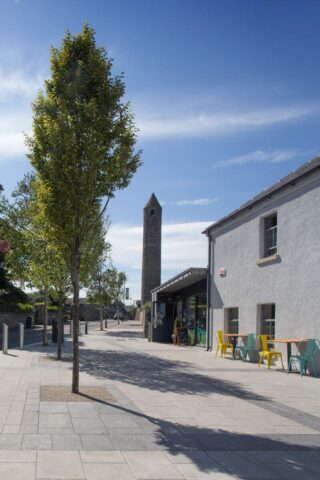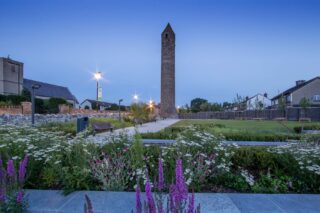Notice
Clondalkin Round Tower is a state-owned National Monument in the care of the Office of Public Works
*External Viewing Only. Internal Access is Not Permitted*
WARNING: It should be noted that these sites are unguided and a level of care and caution should be maintained during all stages of your visit. The Office Of Public Works (OPW) will not be held responsible for any damages, injuries, or losses that occur
Clondalkin Round Tower
This tall and slender round tower was erected on the site of a monastery that was founded in the 7th century by Saint Mochua, otherwise called Saint Cronan. The religious settlement was plundered several times during the Viking raids in the 9th and 10th centuries. Three other such towers can be found in the county of Dublin, at Lusk, Swords and Rathmichael.
In total the tower is 25.6 meters (84 feet) high and stands on a projecting or buttressed base of solid masonry that is 3.9 meters (13 feet) high and reaches up to the entry doorway. In the collection of the National Library of Ireland is an annotated drawing by Gabriel Beranger, dated to 1767, which states that this base was a modern addition and was made to strengthen the tower as it had been damaged in the past.
A report in Saunders’ Newsletter, on Wednesday 25th April 1787, recorded the destruction that an explosion wrought to the Clondalkin neighbourhood when the gunpowder mills at Moyle Park, a short distance south by south-west from the round tower, blew up, causing much damage to buildings that sat between the two locations. Included were the following extracts: "A number of trees were destroyed, and stones of considerable magnitude hurled with a prodigious impetus to the distance of a mile and a half………Several neighbouring and some distant cottages were also unroofed or demolished, and the windows of many habitations on the road to Clondalkin, and round the country for miles, broken….Notwithstanding the violent concussive agitation of the earth, the round tower, which has, for so many ages braved the attacks of the elements, withstood this last assault; part of the gavel end of the old church was however beat down, and several rafters, just laid on the new church, were demolished by some of the stones or pieces of timber which were driven in all directions."
Unlike the tower’s seeming good fortune, a drawing made shortly before this catastrophe by Thomas Archdeakon, of the round tower and the old church that stood nearby, was subsequently annotated with the following information: "A view of Clondalkin Church - These old remains were demolished by the blowing of the powder mills in their neighbourhood sometime after the drawing was made."
As illustrated in an issue of the Dublin Penny Journal in 1833, as well as in other 19th century drawings and engravings, the tower has remained in excellent condition, then, as now, sitting at the very edge of the western side of Tower Road in the centre of Clondalkin village. Directly opposite it, to the east, is St. John’s Church of Ireland, upon which site once stood the earlier church, the ruins of which appear in various drawings up to 1792. This is the church that was damaged by the powder mill explosion.
The tower is believed to be of a very early age, especially given its builders’ use of a rough undressed variety of local calp limestone. Its tall drum is also extremely narrow, its diameter at the widest point being only 4.05 m (13.3 ft) meters. In 1842, in his ’Scenery and Antiquities of Ireland’, William Henry Bartlett wrote that there were no traces of a stairway in the tower but that ladders were put in place so as to enable the curious visitor to reach the uppermost storey. At its topmost level there are four rectangular windows, each aligned to the capital points of the compass. Only one other very small south-facing window can be seen, mid-way up the drum. The tower is topped by what appears to be its original conical stone cap.
The steps that lead from ground level to the entrance door of the tower were added at sometime between 1845 and 1848, as contemporary illustrations show them absent at the earlier date and present at the later one.
The round tower now stands in the south-eastern corner of a very well presented cultural complex, called the Brú Chrónáin Visitor Centre, which contains an excellent museum and café and a very cleverly designed garden that is planted with trees, shrubs and herbs that would have been familiar to the old monastic inhabitants for their medicinal and nutritional qualities.
Protect our Past - Click here to read about the importance of protecting our country’s unique heritage sites
This national monument is protected in accordance with the National Monuments Acts 1930 to 2014
Gallery
Nearby sites to visit
Farmleigh House and Gardens
An eclectic Edwardian mansion and the Irish state guesthouse
Approx. 5.3 km from Clondalkin Round Tower
Phoenix Park and Biodiversity Centre
Where Dublin goes to breathe
Approx. 5.7 km from Clondalkin Round Tower
Irish National War Memorial Gardens
Relax and reflect in this beautiful garden monument
Approx. 6.0 km from Clondalkin Round Tower
Kilmainham Gaol Museum
A monument to more than a century of Irish nationalism
Approx. 6.1 km from Clondalkin Round Tower
Phoenix Park Visitor Centre and Ashtown Castle
A rediscovered medieval gem and its demesne
Approx. 6.5 km from Clondalkin Round Tower
Áras an Uachtaráin
A taste of presidential elegance
Approx. 6.6 km from Clondalkin Round Tower



